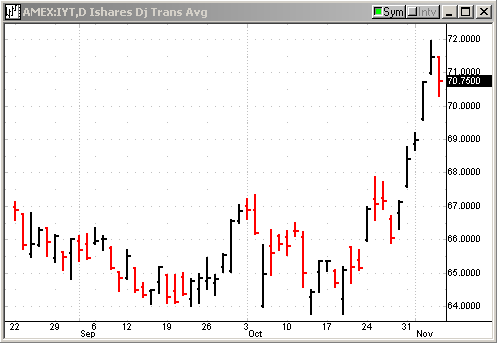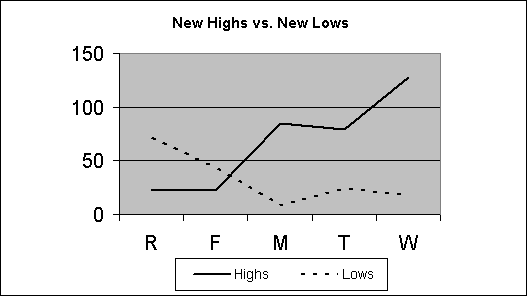Here are 4 markets that lead the world
Upward Bias
for Now
The market has rallied with
some internal strength this week. Lowry’s gave a short-term buy signal that
usually means there’s SOME room on the upside left.  Before last week it
appeared that a soft spell in the US economy was materializing swiftly. Now it
looks likely to develop in the future, but clearly not here yet. We do like
global leaders such as Japan, US transports, insurance, and Latin Banks on the
buy side.
However, global bonds have NOT
yet responded positively, and as we’ve discussed in the past, we are quite
hesitant to expect too much of a rally in the absence of bond strength in this
environment. We therefore continue to suggest caution and less than normal
allocation, even to the strongest instruments and sectors.

Our model portfolio followed in TradingMarkets.com with specific entry/exit/ops
levels from 1999 through May of 2003 was up 41% in 1999, 82% in 2000, 16.5% in
2001, 7.58% in 2002, and we stopped specific recommendations up around 5% in May
2003 (strict following of our US only methodologies should have had portfolios
up 17% for the year 2003) — all on worst drawdown of under 7%.  This did not
include our foreign stock recommendations that had spectacular performance in
2003.

This week in our Top RS/EPS New Highs list published on TradingMarkets.com, we
had readings of 23, 22, 85, 79, and 128 with 59 breakouts of 4+ week ranges, one
valid trade in TRAD and close calls in BBD, TSU, and CMX. This week, our bottom
RS/EPS New Lows recorded readings of 72, 44, 8, 24, and 18 with 19 breakdowns of
4+ week ranges, no valid trades and no close calls. The “model†portfolio of
trades meeting criteria is now long CVCO and TRAD and short NDN and SUP. The
environment is getting trickier and more treacherous and we are chickens when it
comes to risking principle unless it looks like the weather is clear.

For those not familiar with our
long/short strategies, we suggest you review my book
The Hedge Fund Edge. Basically, we have
rigorous criteria for potential long stocks that we call “up-fuel,” as well as
rigorous criteria for potential short stocks that we call “down-fuel.” Each day
we review the list of new highs on our “Top RS and EPS New High List” published
on TradingMarkets.com for breakouts of four-week or longer flags, or of valid
cup-and-handles of more than four weeks. Buy trades are taken only on valid
breakouts of stocks that also meet our up-fuel criteria. Shorts are similarly
taken only in stocks meeting our down-fuel criteria that have valid breakdowns
of four-plus-week flags or cup and handles on the downside. In the U.S. market,
continue to only buy or short stocks in leading or lagging industries according
to our group and sub-group new high and low lists. We continue to buy new long
signals and sell short new short signals until our portfolio is 100% long and
100% short (less aggressive investors stop at 50% long and 50% short). In early
March of 2000, we took half-profits on nearly all positions and lightened up
considerably as a sea of change in the new-economy/old-economy theme appeared to
be upon us. We’ve been effectively defensive ever since, and did not get to a
fully allocated long exposure even during the 2003 rally.

This MAY be a tradeable rally for traders, but it doesn’t yet appear to be the
type of high odds situation we like to sink our teeth into. Traders could
participate on strong RS sectors and watch weak sectors to short against them on
the slightest excuse, but most investors should continue with cautious patience.

Mark Boucher
Mark Boucher has been ranked #1 by Nelson’s World’s Best
Money Managers for his 5-year compounded annual rate of return of 26.6%.
Boucher began trading at age 16. His trading helped finance his education at the
University of California at Berkeley, where he graduated with honors in
Economics. Upon graduation, he founded Investment Research Associates to finance
research on stock, bond, and currency trading systems. Boucher joined forces
with Fortunet, Inc. in 1986, where he developed models for hedging and trading
bonds, currencies, futures, and stocks. In 1989, the results of this research
were published in the Fortunet Trading Course. While with Fortunet, Boucher also
applied this research to designing institutional products, such as a hedging
model on over $1 billion of debt exposure for the treasurer of Mead, a Fortune
500 company.
